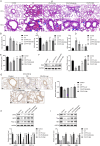Progesterone (P4) ameliorates cigarette smoke-induced chronic obstructive pulmonary disease (COPD)
- PMID: 39138434
- PMCID: PMC11323532
- DOI: 10.1186/s10020-024-00883-y
Progesterone (P4) ameliorates cigarette smoke-induced chronic obstructive pulmonary disease (COPD)
Abstract
Background: Chronic obstructive pulmonary disease (COPD) is a chronic inflammatory lung disease associated with high morbidity and mortality worldwide. Oxidative injury and mitochondrial dysfunction in the airway epithelium are major events in COPD progression.
Methods and results: The therapeutic effects of Progesterone (P4) were investigated in vivo and in vitro in this study. In vivo, in a cigarette smoke (CS) exposure-induced COPD mouse model, P4 treatment significantly ameliorated CS exposure-induced physiological and pathological characteristics, including inflammatory cell infiltration and oxidative injury, in a dose-dependent manner. The c-MYC/SIRT1/PGC-1α pathway is involved in the protective function of P4 against CS-induced COPD. In vitro, P4 co-treatment significantly ameliorated H2O2-induced oxidative injury and mitochondrial dysfunctions by promoting cell proliferation, increasing mitochondrial membrane potential, decreasing ROS levels and apoptosis, and increasing ATP content. Moreover, P4 co-treatment partially attenuated H2O2-caused inhibition in Nrf1, Tfam, Mfn1, PGR-B, c-MYC, SIRT1, and PGC-1α levels. In BEAS-2B and ASM cells, the c-MYC/SIRT1 axis regulated P4's protective effects against H2O2-induced oxidative injury and mitochondrial dysfunctions.
Conclusion: P4 activates the c-MYC/SIRT1 axis, ameliorating CS-induced COPD and protecting both airway epithelial cells and smooth muscle cells against H2O2-induced oxidative damage. PGC-1α and downstream mitochondrial signaling pathways might be involved.
Keywords: Airway epithelium; Chronic obstructive pulmonary disease (COPD); Mitochondrial dysfunction; Oxidative injury; Progesterone (P4).
© 2024. The Author(s).
Conflict of interest statement
Not applicable.
Figures








Similar articles
-
rhCC16 Suppresses Cellular Senescence and Ameliorates COPD-Like Symptoms by Activating the AMPK/Sirt1-PGC-1-α-TFAM Pathway to Promote Mitochondrial Function.J Cell Mol Med. 2025 Apr;29(8):e70566. doi: 10.1111/jcmm.70566. J Cell Mol Med. 2025. PMID: 40259209 Free PMC article.
-
Function of hesperidin alleviating inflammation and oxidative stress responses in COPD mice might be related to SIRT1/PGC-1α/NF-κB signaling axis.J Recept Signal Transduct Res. 2020 Aug;40(4):388-394. doi: 10.1080/10799893.2020.1738483. Epub 2020 Mar 13. J Recept Signal Transduct Res. 2020. PMID: 32164488
-
The Mitochondrial Fusion Promoter M1 Mitigates Cigarette Smoke-Induced Airway Inflammation and Oxidative Stress via the PI3K-AKT Signaling Pathway.Lung. 2024 Dec 3;203(1):12. doi: 10.1007/s00408-024-00766-3. Lung. 2024. PMID: 39625494
-
Is mitochondrial dysfunction a driving mechanism linking COPD to nonsmall cell lung carcinoma?Eur Respir Rev. 2017 Oct 25;26(146):170040. doi: 10.1183/16000617.0040-2017. Print 2017 Dec 31. Eur Respir Rev. 2017. PMID: 29070578 Free PMC article. Review.
-
Autophagy in cigarette smoke-induced chronic obstructive pulmonary disease.Expert Rev Respir Med. 2010 Oct;4(5):573-84. doi: 10.1586/ers.10.61. Expert Rev Respir Med. 2010. PMID: 20923337 Free PMC article. Review.
Cited by
-
Proteogenomic verifies targets underlying erythromycin alleviate neutrophil extracellular traps-induced inflammation.Respir Res. 2025 Apr 19;26(1):155. doi: 10.1186/s12931-025-03226-5. Respir Res. 2025. PMID: 40253327 Free PMC article.
-
Inhaled biologics for respiratory diseases: clinical potential and emerging technologies.Drug Deliv Transl Res. 2025 Jul 14. doi: 10.1007/s13346-025-01909-6. Online ahead of print. Drug Deliv Transl Res. 2025. PMID: 40660066
References
MeSH terms
Substances
Grants and funding
LinkOut - more resources
Full Text Sources
Medical
Research Materials

